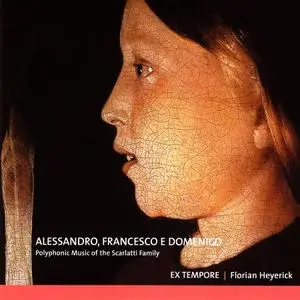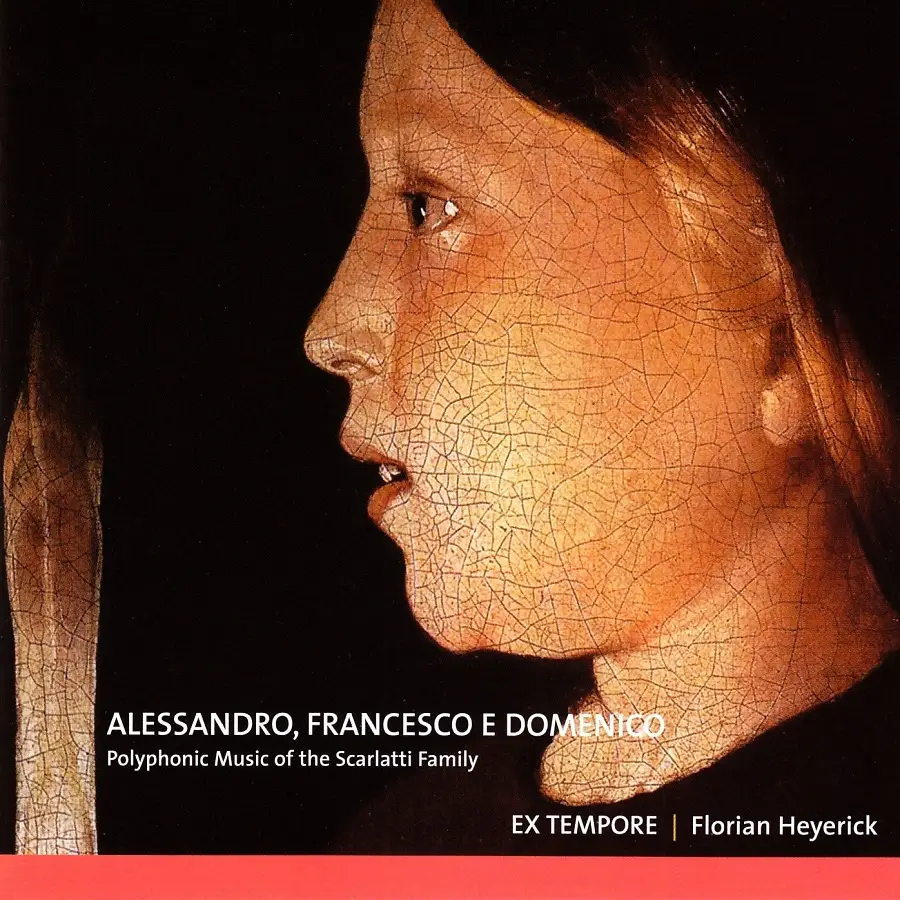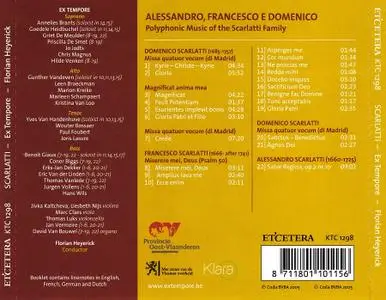Florian Heyerick, Ex Tempore - Alessandro, Francesco e Domenico: Polyphonic Music of the Scarlatti Family (2005)
EAC | FLAC | Image (Cue & Log) ~ 309 Mb | Total time: 70:44 | Scans included
Classical | Label: Et'cetera | # KTC 1298 | Recorded: 2005
EAC | FLAC | Image (Cue & Log) ~ 309 Mb | Total time: 70:44 | Scans included
Classical | Label: Et'cetera | # KTC 1298 | Recorded: 2005
The Scarlatti family is one of many musical dynasties in music history. Only two of its number are still well-known today: Alessandro and his son Domenico. Alessandro was born in Palermo as the second son of Pietro Scarlata - the family name in its original form - who was active as a tenor. During his career Alessandro lived and worked in several cities: Rome, Naples and Venice. At a young age he was already a famous and much sought-after composer. His younger brother Francesco – almost forgotten today - was less lucky. He was appointed as violinist at the royal court in Naples in 1684, but returned to Palermo in 1691, and stayed there for about 24 years. He tried to find appointments at the courts of Vienna and Naples, but failed. In 1719 he travelled to London, where he participated in public concerts. In 1733 he went to Dublin, where he seems to have died in 1741 or soon after. Domenico suffered tribulations too. It was only after the death of his father that he felt completely free to follow his own path, although he had left Italy five years earlier, in 1720.
This disc pays attention to a part of the oeuvre of the Scarlatti family which is rarely performed and recorded. As the title of this disc indicates, its subject is an exploration of how these three Scarlattis dealt with polyphony. The Council of Trent (1545-1563) stated that polyphony, and in particular polyphony as applied by Giovanni Pierluigi da Palestrina, was the best way to implement the liturgical ideals of the Church. But at the beginning of the 17th century the musical aesthetics fundamentally changed: the text was put into the centre, and the music was supposed to express the affetti of the text. But polyphony continued to play an important role in the style of composing during the 17th and 18th centuries, in Italy and elsewhere. There were two ways of using polyphony, and both can be heard on this disc.
In most cases the polyphony is enriched by the declamatory style and the harmonic freedoms of the stile nuovo. Domenico Scarlatti composed a number of works in this 'mixed' style. These included his ten-part Stabat mater and the setting of the Magnificat which is recorded here. Examples of text expression are the staccato on "dispersit superbos" (scattered the proud) and the ascending figure on "exaltavit" (exalted). Domenico's uncle Francesco goes much further in his setting of the Miserere (Psalm 50/51). The first two verses are full of dissonances, and in the 18th verse strong dissonances are used again on the words "contribulatus" (broken [spirit]) and "contritum" (contrite [heart]). Francesco demonstrates his contrapuntal skills in the doxology, where he writes a double fugue in eight parts on the passage "et in saecula saeculorum". Alessandro Scarlatti's setting of the Salve Regina was published in a collection of sacred pieces, printed in Amsterdam in 1707/8. In it he grasps the opportunities to translate text into music.
In the 17th and 18th centuries some music was still written in the old-fashioned polyphonic style, the stile antiquo. Alessandro Scarlatti referred to his compositions in this style as written "alla Palestrina". On this disc the Mass by his son Domenico represents this style. It is written for four voices and b.c. It was found in an archive in Madrid which drew the nickname 'Missa di Madrid'. From this one may conclude that it was written during his time in Spain. Here there is hardly any connection between text and music, except some madrigalisms here and there. His use of harmony in this work is conservative.
The ensemble Ex Tempore give fine performances here. The fact that some pieces are written in the stile antico of the 16th century does not mean that they should be performed as renaissance music. Fortunately Florian Heyerick is well aware of this, which is reflected in a more declamatory style of singing and the presence of greater dynamic contrast than would be appropriate in real 16th-century music. The Miserere by Francesco Scarlatti contains a number of solo sections which are sung by members of the ensemble, and they do so very well.–Johan van Veen
Performer:
Ex Tempore
Conductor - Florian Heyerick
Track List:
Domenico Scarlatti (1685 - 1757)
01. Missa quatuor vocum (di Madrid): I. Kyrie - Christe - Kyrie
02. II. Gloria
03. Magnificat anima mea: I. Magnificat
04. II. Fecit Potentiam
05. III. Esurientes implevit bonis
06. IV. Gloria Patri et Filio
07. Missa quatuor vocum (di Madrid), Credo
Francesco Scarlatti (1666 - after 1741)
08. Miserere mei, Deus (Psalm 50): I. Miserere mei, Deus
09. II. Amplius lava me
10. III. Ecce enim
11. IV. Asperges me
12. V. Cor mundum
13. VI. Ne proicias me
14. VII. Redde mihi
15. VIII. Docebo iniquos
16. IX. Sacrificium Deo
17. X. Benigne fac domine
18. XI. Tunc acceptabis
19. XII. Gloria Patri
Domenico Scarlatti (1685 - 1757)
20. Missa quatuor vocum (di Madrid): I. Sanctus - Benedictus
21. II. Agnus Dei
Alessandro Scarlatti (1660 - 1725)
22. Salve Regina, Op. 2 No. 10
Exact Audio Copy V1.5 from 20. February 2020
EAC extraction logfile from 30. November 2020, 16:45
Ex Tempore, Florian Heyerick / Polyphonic Music of the Scarlatti Family
Used drive : PIONEER DVD-RW DVR-218L Adapter: 1 ID: 0
Read mode : Secure
Utilize accurate stream : Yes
Defeat audio cache : Yes
Make use of C2 pointers : No
Read offset correction : 6
Overread into Lead-In and Lead-Out : No
Fill up missing offset samples with silence : Yes
Delete leading and trailing silent blocks : No
Null samples used in CRC calculations : Yes
Used interface : Native Win32 interface for Win NT & 2000
Used output format : User Defined Encoder
Selected bitrate : 128 kBit/s
Quality : High
Add ID3 tag : No
Command line compressor : C:\Program Files\Exact Audio Copy\Flac\flac.exe
Additional command line options : -V -8 -T "Date=%year%" -T "Genre=%genre%" %source%
TOC of the extracted CD
Track | Start | Length | Start sector | End sector
––––––––––––––––––––––––––––-
1 | 0:00.00 | 4:33.48 | 0 | 20522
2 | 4:33.48 | 5:55.01 | 20523 | 47148
3 | 10:28.49 | 4:21.66 | 47149 | 66789
4 | 14:50.40 | 1:38.23 | 66790 | 74162
5 | 16:28.63 | 4:27.59 | 74163 | 94246
6 | 20:56.47 | 3:12.35 | 94247 | 108681
7 | 24:09.07 | 7:23.23 | 108682 | 141929
8 | 31:32.30 | 3:11.44 | 141930 | 156298
9 | 34:43.74 | 2:39.70 | 156299 | 168293
10 | 37:23.69 | 2:11.52 | 168294 | 178170
11 | 39:35.46 | 1:44.27 | 178171 | 185997
12 | 41:19.73 | 1:34.62 | 185998 | 193109
13 | 42:54.60 | 1:46.50 | 193110 | 201109
14 | 44:41.35 | 1:08.15 | 201110 | 206224
15 | 45:49.50 | 3:09.74 | 206225 | 220473
16 | 48:59.49 | 2:23.36 | 220474 | 231234
17 | 51:23.10 | 1:21.05 | 231235 | 237314
18 | 52:44.15 | 1:16.49 | 237315 | 243063
19 | 54:00.64 | 2:37.63 | 243064 | 254901
20 | 56:38.52 | 2:31.40 | 254902 | 266266
21 | 59:10.17 | 2:31.25 | 266267 | 277616
22 | 61:41.42 | 9:02.34 | 277617 | 318300
Range status and errors
Selected range
Filename C:\ArlegZ\Polyphonic Music of the Scarlatti Family - Ex Tempore.wav
Peak level 94.7 %
Extraction speed 2.0 X
Range quality 100.0 %
Test CRC 25120B0E
Copy CRC 25120B0E
Copy OK
No errors occurred
AccurateRip summary
Track 1 accurately ripped (confidence 2) [AB6C3E01] (AR v2)
Track 2 accurately ripped (confidence 2) [051F7355] (AR v2)
Track 3 accurately ripped (confidence 2) [40173670] (AR v2)
Track 4 accurately ripped (confidence 2) [F2AC79F9] (AR v2)
Track 5 accurately ripped (confidence 2) [64C1716B] (AR v2)
Track 6 accurately ripped (confidence 2) [E58B029A] (AR v2)
Track 7 accurately ripped (confidence 2) [58B68D1D] (AR v2)
Track 8 accurately ripped (confidence 2) [9FC62173] (AR v2)
Track 9 accurately ripped (confidence 2) [6D03ADB7] (AR v2)
Track 10 accurately ripped (confidence 2) [EC9449BE] (AR v2)
Track 11 accurately ripped (confidence 2) [52DEEA17] (AR v2)
Track 12 accurately ripped (confidence 2) [C1C0FB98] (AR v2)
Track 13 accurately ripped (confidence 2) [644A660F] (AR v2)
Track 14 accurately ripped (confidence 2) [11D0442F] (AR v2)
Track 15 accurately ripped (confidence 2) [6B9FA03F] (AR v2)
Track 16 accurately ripped (confidence 2) [95F89EB7] (AR v2)
Track 17 accurately ripped (confidence 2) [733739BC] (AR v2)
Track 18 accurately ripped (confidence 2) [A0B8B279] (AR v2)
Track 19 accurately ripped (confidence 2) [ABAF0C8E] (AR v2)
Track 20 accurately ripped (confidence 2) [FE5D8397] (AR v2)
Track 21 accurately ripped (confidence 2) [B52CA6D3] (AR v2)
Track 22 accurately ripped (confidence 2) [8BE48954] (AR v2)
All tracks accurately ripped
End of status report
–– CUETools DB Plugin V2.1.6
[CTDB TOCID: s.C6wtyq1nwQaokpY9_1CCd5eo4-] disk not present in database
Submit result: s.C6wtyq1nwQaokpY9_1CCd5eo4- has been uploaded
==== Log checksum 6486C9079A172922FA095CD32EA54F92D78658A4C325CFD5266ABD3FB1150477 ====





